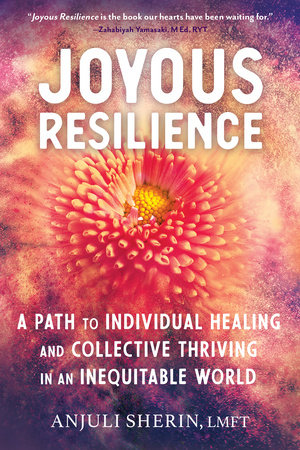
New Release Excerpt: Joyous Resilience
Categories: Excerpt Health & Healing New Release

An excerpt from Joyous Resilience: A Path to Individual Healing and Collective Thriving in an Inequitable World by Anjuli Sherin
With self-nurturance and compassion, the proof, as the saying goes, is in the pudding. Folks practicing self-compassion clearly exhibit and share the improved mood, sense of self, and well- being that point to the power of this practice. Through research we now know that when practicing compassion, our heart rate slows down, and we secrete oxytocin, the “bonding hormone,” which allows us to feel safe, connected, and caring toward others. Not only is this essential for our own sense of well-being, it also provides a biological imperative for relating to others, providing care, and fostering societies that are interdependent rather than isolated and violent.
The practice of self-compassion, which is the primary practice of the Nurturer in this section, has similar results, according to self-compassion research expert Kristen Neff, with the added benefit that unlike solely building self-esteem, we no longer need to “see ourselves as perfect or better than others.” Kristen’s studies have showed that “self-compassion is a powerful way to achieve emotional well-being and contentment in our lives, helping us avoid destructive patterns of fear, negativity, and isolation.” In other words, we need the practice of nurturance and self- compassion to thrive internally and to create relationships and a society that is considerate and works toward more positive impact on each other.
From a developmental standpoint, science backs up the assertion that attunement (the key skill set of a Nurturer) is the essential predictor of childhood resilience. It’s time to abandon the myth that picking up our babies when they cry, comforting them, and being aware of their needs is “spoiling” them. Instead, promptly responding to a baby’s distress during the first six months of their life by picking them up leads to four proven outcomes by the end of their first year: they cry less, learn to self-soothe, are able to receive their caregivers’ attempts at soothing more quickly, and develop a secure attachment with the caregiver, providing a solid grounding for resilience into adulthood. Guess what? The same applies to our responsiveness to ourselves and each other as adults. Paying attention to our distress and having a prompt and kind response most of the time leads to the same results: fewer instances of emotional upset, greater ability to bounce back from a difficult event, feeling more secure in ourselves and our relationships with others, and shifting our attachment style from anxious or avoidant to secure.
Author Nora Samaran makes a powerful point along these lines when she writes, “Violence and nurturance are two sides of the same coin. Compassion for self and compassion for others grow together and are connected; this means that men finding and recuperating the lost parts of themselves will heal everyone.” This is what makes Kamal’s story so poignant, and this work of self-compassion so crucial to the times we live in. By practicing the skill of self-compassion we are helping ourselves open to the whole host of traits that not only transform our own psychobiology; they also change the psychobiology of our relationships.
How can we begin to build a world that feels like a place that is safe, connected, loving, and inclusive for us and our children, when we don’t have internal knowledge of what attuned care feels, sounds, and acts like—and that we deserve it? We deserve such a world not because we have earned it by belonging to a certain group, earning a certain amount, or being a certain gender or age or race, but as a basic standard of care. We only have to turn on the news, or look around at the state of our world, to see what happens when nurturance is not at the foundation of society. As Samaran writes, “The opposite of rape culture is nurturance culture.” When men are conditioned to think emotions are weak, they are taught to disconnect from the very traits of attunement, feeling, and providing emotional safety, love, trust, and nurturance that we as humans are wired to exhibit in order to communally thrive. Instead, by shaming fifty percent of the human population to shut down their vulnerability, we have created what Samaran describes as a culture of violence. We must instead seek a culture of nurturance and compassion that will allow us to flourish, to appreciate the beauty and richness of life even in hard times, and continue to orient ourselves and our communities toward what gives us all joy.
Your Nurturing Practices
- If you haven’t done so already, take some time now to do exercises 1–4 in this chapter, to build your inner Nurturer and safe space and begin connecting with this part of yourself.
- Take a few minutes each day, and then a longer chunk of time (fifteen to thirty minutes) one day per week, to pause, focus on and relax your breathing, go to your safe space, and visualize and connect with your inner Nurturer. As the inner Nurturer, ask yourself the following three questions, and answer them, either in your mind, out loud, or in your journal:
- How are you? (Answer by describing your sensations and emotions.)
- Is there anything your heart wants to share?
- Is there any way I can support you with this right now, or is listening enough?
- For each of these questions, take some time for your response, and then breathe and imagine, feel, see, sense, hear, or perceive the Nurturer attuning to you and shar-ing anything they have to share. When in doubt, you can always practice the nurturing statements you chose earlier, or simply respond as the Nurturer saying, “I hear you. I love you and I am here for you.” If you share any needs you have, take time as the Nurturer to see if you can say yes to them in the moment or commit to meeting this need at a later time. Make a plan to meet this need, and if in doubt, get help from a loved one or counselor.
- Once you have built this daily connection to your inner Nurturer, identify one to three areas in your life that the Nurturer can begin to assist you with. This could be setting up self- care in your daily routine, eating three healthy meals every day, setting a timer during the day to remind you to pause and take ten deep breaths to destress, choosing five nurturing statements you’d like to hear said out loud to yourself each day that relate to a particular area you want support in, or setting aside time to be out in nature each day.
- Create a self-care list, based on the information you go through in the exercises in this chapter, that you can turn to in times of stress. What are the top ten things that help you feel better emotionally? See if you can have at least one or two of them be ways of emotional release that we learned from the chapter on the Vulnerable Self. For example, I let myself write out my feelings in my journal, I allow myself to listen to music and cry, or I talk things out with a close friend.
Each of these practices will build a new foundation inside you, teaching you the art of nurturing attunement: pause and notice yourself, bring a positive regard and loving acceptance to what is occurring, and identify and meet your needs in a healthy, caring manner. Get ready to feel more confident and successful in your ability to care for yourself and to be present with and supportive of others!
You may read through to the end of the book and then come back to this chapter to begin your practices, or you may complete these first before moving on. You will want to at least complete the first practice in this chapter before moving on to the practices in the next one, as they build upon each other. I encourage you to practice each chapter’s exercises over a month before moving on to the exercises in the next chapter. Perhaps practice the first exercise in each chapter for a week before adding the next, so that you cover all four exercises in a month. You may always repeat an exercise for several months before moving on, to help yourself deepen and master it.
If you’re noticing any resistance to receiving or giving nurturance as you go through these exercises, here’s a gentle reminder: if we are not used to being loved and nurtured, it can be hard to give ourselves this gift, and the voice of the Critic can come up rather strongly, making us feel guilty or avoidant. For now, simply think of any difficult emotions that arise as a chance to practice nurturance. The same rules apply: bring your acceptance and desire to understand this part of you that is having difficulty, and just allow these feelings to exist and have room. As the inner Nurturer, say, “I know you are having a hard time. I understand. Let it all out, and I will listen without judgment. If I can do anything, let me know. I am here to love you, and you can receive whenever you are ready and at whatever pace you choose.”
Here’s the beauty of nurturance: just as we would care for a child on a day when they’re having a temper tantrum or acting in ways that are frustrating, so will we continue to care for and check in with our inner selves even when we’re shutting down. It is this steady, unwavering commitment to care for ourselves when we’re stuck that will build up self-trust and allow us to dig deeper and help even our most painful parts be understood and heal over time.
Nurturing and self-compassion are a muscle, and this is a lifelong practice. Start where you are, and trust that you will see positive results more quickly than you think. You have this amazing power within your grasp that is not dependent on anyone else: the power to help yourself feel better and to put a smile on your face and a glow in the eyes of the person you see every day in the mirror. Pay attention to you. It is said that children are so wonderful because they are so responsive to us and simply want to please us and are so easily gratified by our attention. I have found our own heart is rather like that vulnerable child. Watering it with kind words and loving attention does begin to melt it. It is worth the effort. Start now. Put your hand on your heart, take three breaths in there to bring your presence to yourself, and then simply let your heart know: I love you just as you are. I am learning to nurture you. I am not perfect, and I don’t need you to be. We can love each other and care for each other just as we are. I want you to be happy. How are you? Is there anything you need?




